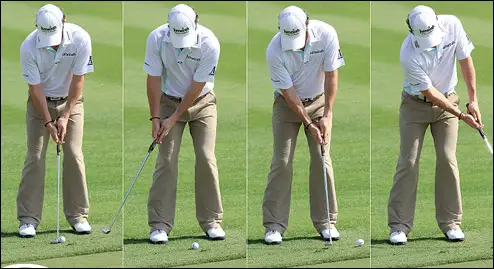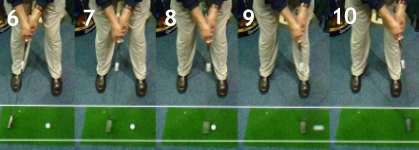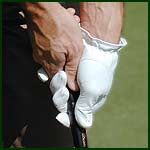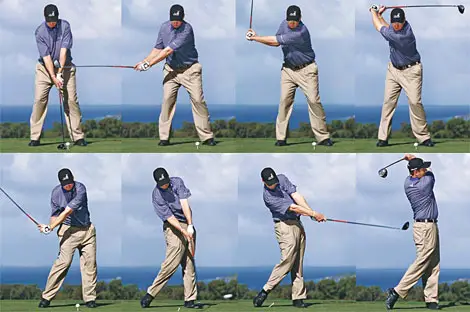BASIC PUTTING STROKE
You can see that the putter head stays between the 2 white lines in the images below.


This helps create a pendulum motion with very little in-to-out movement (only back to front).
The ideal putting stroke is a straight back and straight through stroke.
This type of movement is important in creating consistency with your putting. You can also see below that the wrists stay straight on the backswing and follow-through.
CROSS HANDED PUTTING
One common error inputting is a breakdown of the wrists – The left wrists should work as a unit!
If this problem applies to you, try using a “cross-hand” grip.
To do this, place the left hand down the grip where the right hand would normally be and put the right hand at the top of the grip.

Here is how you should go about trying it:
Line the putter up to the target with your RIGHT hand.
Once you are lined up, then place your left hand on the club. Your left pinky should rest on top of your right index finger.
Hit the putt! In this case, your left hand (the bottom hand), along with your left arm and left shoulder, leads the way. Feel like your left arm is a lever, and you are simply swinging it like a pendulum.
This may feel odd at first, but it forces the hands to work as a unit, which is one of the fundamentals of good putting. And remember: Always keep the hands in front of the ball during the stroke and the left wrist flat!
KEEP YOUR EYE ON THE MARKER
All of us tend to look up too quickly to see if we have made our putts or not – sound like you? – READ FURTHER…
Here’s a simple drill that will put discipline back in your stroke and make you more positive.
Place the ball on top of a flat marker on the green about 3-4 cm behind the ball.
Keep your eyes focused on the marker all the way through your stroke.
Avoid the urge to follow the ball with your eyes immediately after impact—especially on short putts.
Just watch for the marker, rather than following the ball with your eyes, head, and shoulders.
FACE BALANCED PUTTER
(Don’t know if your putter is face-balanced? Balance your putter shaft on your finger. If the face points skyward, it’s face-balanced. If the toe points downward, it’s not face-balanced.)
If you place a putter’s shaft balanced on your fingertip and the face of the putter head runs parallel to the horizon – face to the sky – then it is called “face-balanced.” Big mallets such as the Taylor Made Monza (Above) are generally face-balanced. Most center-shafted putters or heel-shafted putters with shafts bent to create a central axis are face-balanced.
Pure pendulum strokes need a balanced weight distribution to maintain stability and keep the face square through impact. Face-balanced putters work better with a stroke that moves straight down the line – straight back and straight through.
Therefore if you have a face-balanced putter, you must have a straight back and straight through putting stroke to get the full benefit from the putter. The face-balanced putters are noticeably less effective when used with an arced putting stroke.
HITCHHIKE TO BETTER PUTTING
Here’s a good image to keep in mind during your backswing: Think of placing your right hand in a “hitchhiker” position.

image credit
This means that when the club is at waist height, you should be able to look back and see your thumb pointing to the sky. Here’s another trick: Imagine that your hand is in a handshake position, with the palm facing neither up nor down.
These simple thoughts will ensure the beginning of your swing is correct!
PRE-SHOT PUTTING MACHINE
Before every putt, stand behind the ball, face the hole, and imagine the path the ball will take on its way into the hole. “See” the ball go into the hole and “hear” the sound it will make as it clanks to rest in the hole. Imagination is critical in golf.
Then take two or more rehearsal strokes while looking at the hole. Rehearse exactly what you intend to do (note: you may stand to the side of the ball rather than behind it if it feels more comfortable). Don’t practice your mechanics. Try to feel the stroke required to make the ball roll the proper distance. While you make these “feel it” rehearsal strokes, again, imagine the ball rolling into the hole.
You are creating a connection between yourself and the target, not practicing your stroke. The more clearly you can “see it” and “feel it,” the better your connection will be. Get this point straight: Practice strokes are for working on your mechanics. Rehearsal strokes are for making putts.
While standing behind the ball (you have not yet addressed the ball), pick out a small target, such as a blade of grass, that the ball will roll over (or toward) on its way to the hole, and lock that target in your mind. Try to see a path from your ball to the target.
Step up to the ball and aim your putter. Next, align yourself (take your stance) to the putter. Then run your eyes back and forth along the line to the target. Do this “tracking” with your eyes slowly, and try not to let your eyes “jump” along the line (that will take some practice). Then, when your brain tells you that you are ready, put the ball. If it goes in, take it out of the hole. If not, repeat the process.
TILE PUTTING
Use A Tile Floor To See What “Square” Looks Like
A common flaw in the golf swing or putting stroke occurs before the swing is made in that the stance and clubhead are not square to the target line.
It is all a matter of personal perception.
Every player should work out what the square looks like and store the images in visual and muscle memory.
PUTTING OFF THE TOE OF THE PUTTER
Downhill putts are difficult. Try doing what a lot of the Pro’s do – hit the ball off the toe of the putter:
Downhill putts tend to be fast and difficult. Hit the ball on the toe of the putter, not on the sweet spot.
This tends to “deaden” the jump on the ball and stops it from going way past the hole. Don’t do this on uphill putts, though!
